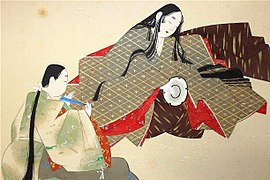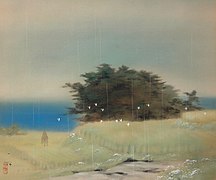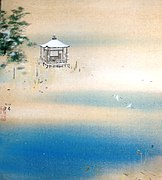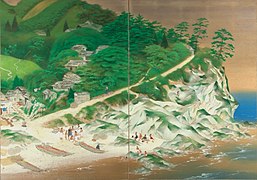Matsumoto Ichiyō
Matsumoto Ichiyō ( Japanese 梥 本 一 洋 , actually Matsumoto Konnosuke (梥 本 謹 之 助); born November 29, 1893 in Kyoto ; died March 9, 1952 ) was a Japanese painter of the Nihonga direction of the Taishō and Shōwa Time .
life and work
Matsumoto Ichiyō was the son of a family that were involved in making kimonos. His older brothers Takeo (武雄) and Hideo (英雄) also wanted to be a painter, but Hideo then took over the business. - Ichiyō graduated from the “Municipal School of Arts and Crafts Kyōto” (京都 市立 美術館 学校) in 1912 and then continued his training at the “Municipal School of Painting” (京都 市立 絵 画 専 門 学校). After graduating in 1915, he trained under Yamamoto Shunkyo and after his death in 1933 under his successor Kawamura Manshū (川村 川村 舟; 1880-1942), joined the Sanae group (早苗 会) at the same time.
In 1919 Matsumoto was able to show a picture for the first time at the 1st Teiten exhibition, namely "秋 の 夜 長 物語" (Aki no yoru nagamonogatari, long story evening in autumn). He then exhibited pictures at all of the following exhibitions. In 1927 he showed "蟬 丸" (Semimaru) at the 8th exhibition and in 1928 at the 9th the picture "餞 春" (Senshun): both received a special award. From classic material he created narrative pictures, including genre pictures, which initially emphasized the beautiful, but then became simpler and a new variant of the Yamato-e in the Shōwa period . From 1943 Yamamoto was a member of the jury of the Teiten and from the Shin-Bunten he was able to exhibit without a jury. After the war he became an advisor to the Nitten. - From 1936 Yamamoto was a professor at the Municipal School of Painting in Kyoto, and when the Sanae group disbanded after Kawamura's death, he organized the "耕 人 会" (Kōjin-kai), which he took over.
At the Japanese Painting Exhibition in Berlin in 1931, his picture “The Minister of Lanterns” was shown.
photos
Remarks
- ↑ a b c Teiten ( 帝 展 ) is the abbreviation for the annual state art exhibition ( 帝国 美術展 覧 会 , Teikoku bijutsu-in tenrankai ) between 1919 and 1935. The predecessor from 1907 to 1918 was called Bunten (文 展) for Mombushō bijutsu tenrankai ( 文部省 美術展 覧 会 ), the successor from 1936 to 1944, a shin (新) for “new” was placed in front of it. The successor from 1946, now no longer state-owned, was called Nitten for ( 日本 美術展 覧 会 , Nihon bijutsu-in tenrankai ).
- ↑ Semimaru was a poet and musician of the Heian period .
- ↑ Taira no Shigemori (平 重 盛; 1138–1179) received this name because he had equipped a shrine he built near Kyoto with countless lanterns. The temple service was performed by 48 young girls who had to call out the name of Buddha in the presence of Shigemori in the evening after the service in the presence of Shigemori, singing solemnly and banging gongs.
- ↑ One of the eight views of Lake Biwa .
literature
- National Museum of Modern Art, Kyoto (ed.): Matsumoto Ichiyō In: Kyōto no Nihonga 1910–1930. National Museum of Modern Art, Kyoto, 1986. ISBN 4-87642-117-X .
Web links
| personal data | |
|---|---|
| SURNAME | Matsumoto, Ichiyō |
| ALTERNATIVE NAMES | 梥 本 一 洋 (Japanese); Matsumoto Konnosuke (real name); 梥 本 謹 之 助 (real name, Japanese) |
| BRIEF DESCRIPTION | Japanese painter |
| DATE OF BIRTH | November 29, 1893 |
| PLACE OF BIRTH | Kyoto |
| DATE OF DEATH | March 9, 1952 |






